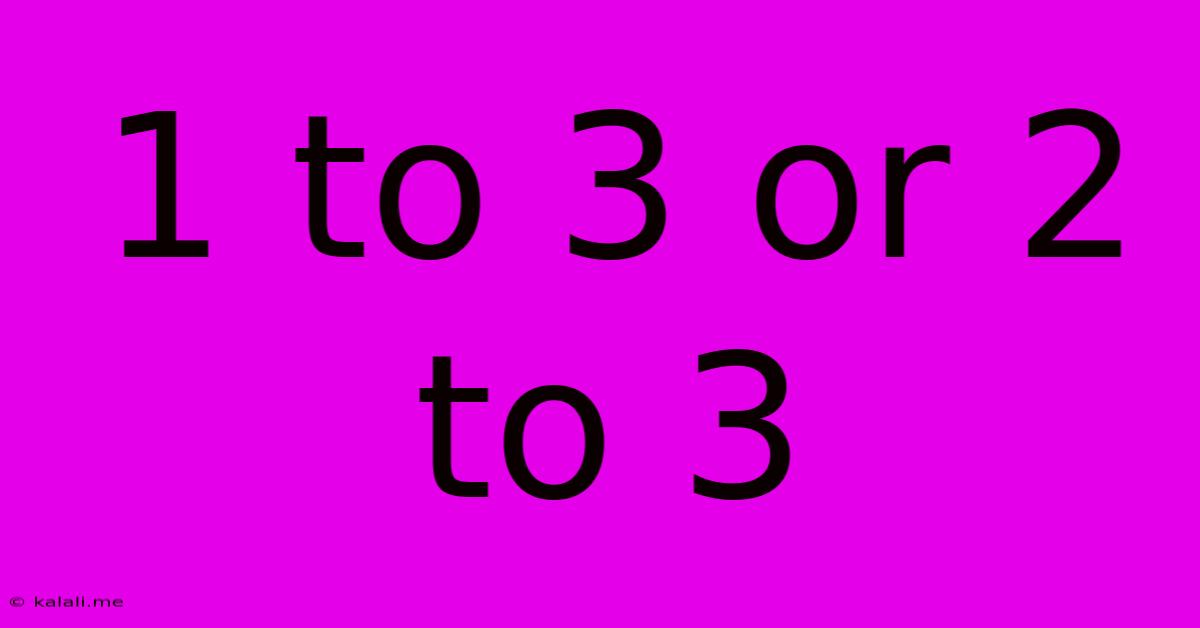1 To 3 Or 2 To 3
Kalali
May 31, 2025 · 3 min read

Table of Contents
1 to 3 or 2 to 3: Understanding the Nuances of Number Ranges
This article explores the subtle yet significant differences between number ranges like "1 to 3" and "2 to 3," focusing on their implications in various contexts. Understanding these distinctions is crucial for clarity and precision in communication, programming, and data analysis. We'll delve into practical examples to illustrate the impact of seemingly minor numerical variations.
Inclusive vs. Exclusive Ranges
The key difference lies in the inclusivity or exclusivity of the endpoints. "1 to 3" typically represents an inclusive range, encompassing all numbers from 1, 2, and 3. Conversely, a range like "2 to 3" also implies inclusivity unless otherwise specified; it includes 2 and 3. However, the context is crucial; sometimes, a range might be implicitly exclusive, especially in programming or mathematical notation.
For example, consider a scenario where you're selecting items from a list numbered 1 to 3. "1 to 3" clearly means you'll select items 1, 2, and 3. On the other hand, if the instruction was to select items "from 2 to 3", it logically includes both item 2 and item 3. This seemingly minor difference in wording can have a significant impact on the outcome.
Implications in Programming
In programming, the interpretation of number ranges can differ depending on the programming language and how the range is specified. Some languages use inclusive ranges by default, while others might be exclusive, requiring specific syntax to include the upper bound. For instance, Python's range(1, 4) generates a sequence including 1, 2, and 3 (inclusive), whereas some other languages might require a different approach to achieve the same result. This highlights the importance of understanding the specific language's conventions when dealing with numerical ranges within code. Incorrect interpretation can lead to bugs and unexpected results.
Applications in Data Analysis and Reporting
The precision of number ranges is critical in data analysis and reporting. Using the correct range ensures that your data is accurately represented and avoids misinterpretations. For example, when reporting data on age groups, stating an age range as "25 to 35" implies inclusivity, meaning it encompasses individuals aged 25, 26, ..., 35. A vague or improperly defined range can lead to skewed results and inaccurate conclusions. Careful specification avoids ambiguous data representation, promoting data integrity and accuracy.
The Importance of Clarity in Communication
Regardless of the context, clear and unambiguous communication about number ranges is paramount. To avoid confusion, always specify whether the range is inclusive or exclusive. When in doubt, explicitly state "inclusive" or "exclusive" to remove any ambiguity. For instance, writing "from 1 to 3 (inclusive)" leaves no room for misinterpretation. This simple step contributes significantly to effective communication and prevents misunderstandings.
Conclusion: Precision Matters
While the difference between "1 to 3" and "2 to 3" might seem insignificant at first glance, understanding the implications of these numerical ranges is vital across various domains. Paying close attention to the inclusivity or exclusivity of the endpoints ensures accuracy, prevents errors, and promotes clear communication. This attention to detail contributes to better results in programming, data analysis, and all forms of numerical communication.
Latest Posts
Latest Posts
-
How To Merge By Used Google Maps
Jun 01, 2025
-
Credit Default Swap The Big Short
Jun 01, 2025
-
How Do You Find The Perimeter Of A Right Triangle
Jun 01, 2025
-
Can I Use Hand Soap As Body Wash
Jun 01, 2025
-
What Does Re Stand For In Email
Jun 01, 2025
Related Post
Thank you for visiting our website which covers about 1 To 3 Or 2 To 3 . We hope the information provided has been useful to you. Feel free to contact us if you have any questions or need further assistance. See you next time and don't miss to bookmark.